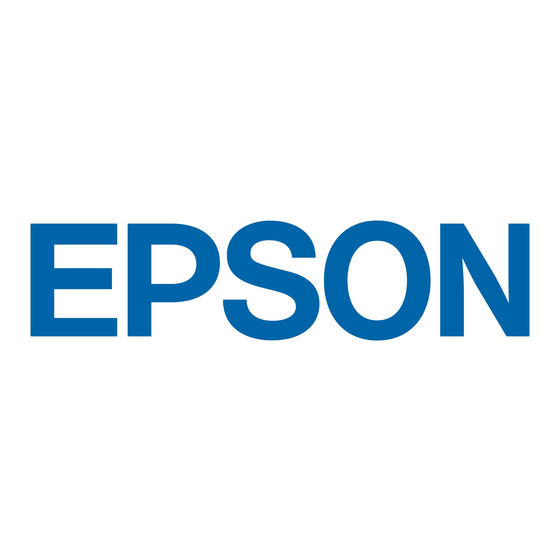- ページ 5
プリンターアクセサリー Epson LQ-1070+のPDF 製品情報マニュアルをオンラインで閲覧またはダウンロードできます。Epson LQ-1070+ 8 ページ。 Product support bulletin(s)
Epson LQ-1070+ にも: 製品サポート速報 (20 ページ), 製品サポート速報 (5 ページ), 製品情報マニュアル (8 ページ), インストールマニュアル (1 ページ), 製品サポート速報 (16 ページ)

Input buffer capacity
The printer stores print data sent from your computer in its input
buffer. Keep DIP switch l-7 off to select an 8Kbyte buffer.
Skip-over-perforation
Turning DIP switch l-8 on when you are using continuous paper
enables the skip-over-perforation function Use this function to leave
a l-inch (25.~mm) margin between the last printable line on one
page and the first printable line on the next page. This causes the
printer to skip over the perforation between continuous sheets.
Most application programs take care of the top and bottom margins.
Do not turn on skip-over-perforation unless your program does not
provide these margins.
Adjust your top-of-form position with the MICRO
half of the margin at the bottom of one page and half at the top of the
next page.
Continuous paper page length
When you are printing on continuous paper, DIP switches 2-1 and
2-2 let you select from the four page lengths described in DIP-switch
Table 5.
Tear off
When you turn DIP switch 2-3 on, the tear-off feature is automatic
when using continuous paper. The printer automatically advances
the last printed page to the tear-off position You can then easily tear
off the printed paper.
The printer automatically returns the paper to the loading position
when it receives more print data. You can also return the paper to the
loading position by pressing the TEAR
button.
Use the tear-off feature only with continuous paper loaded with the
push tractor. Do not use the tear-off feature with the pull tractor.
Auto line feed
When auto line feed is on (DIP switch 2-4 on), the printer
accompanies each carriage-return code (CR) received with a linefeed
code (LF).
If your printer is double spacing, turn DIP switch 2-4 off. If each line
overprints the next, turn DIP switch 24 on
Interface Specifications
Your printer is equipped with a parallel interface.
Specifications and pin assignments
The built-in parallel interface has the following characteristics:
p a r a l l e l
STROBE pulse
Synchronization:
Handshake timing:
BUSY and m signal
Signal led:
or equivalent
24-Pin Printers
FEED buttons
to get
OFF
LOAD/EJECT
button or the
Connector pin assignments and a description of their respective
interface signals are shown in the following table.
Dlrectkn
IN
DATA DATA 2 1
4
DATA 3
5
DATA 4
DATA 5
6
24
7
25
DATA 6
DATA DATA 8 7
ACKNLG
10
28
11
29
BUSY
OUT
12
30
PE
OUT
I
I
13
SLCT
OUT
IN
31
16
IN
32
OUT
ERROR
OUT
IN
Note:
The column heading "Direction" refers to the direction of signal
l
flow as viewed from the printer.
.
"Return" denotes the twisted-pair return to be connected at
signal ground level. For the interface wiring be sure to use a
twisted-pair cable for each signal and to complete the
connection on the return side.
All interface conditions are based on TTL level. Both the rise
l
and fall times of each signal must be less than 0.2 microseconds.
Data transfer must be carried out by observing the ACKNLG or
l
BUSY signal. (Data transfer to this
only after receipt of the ACKNLG signal or when the level of
the BUSY signal is LOW.)
LQ-1070+
.
STROBE pulse to read data. Pulse-
width must be more than 0.5
microseconds at the recervrng
terminal.
These signals represent informatron
of the 1 st to 8th bits of parallel data,
respectively. Each signal is at HIGH
level when data is logical 1 and
LOW when it is logical 0.
About an 11 -microsecond pulse.
LOW indicates that data has been
received and that the printer is
readv to acted more data.
HIGH signal indicates that the
printer cannot receive data. The
signal goes HIGH in the followrng
cases:
1) During data entry (ea. char. time)
2) During printing
3) During PAUSE
4) During printer-error state
A HIGH sianal indicates that the
printer is &t of paper.
Pulled up to 5V through 3.3 Kohm
resistance.
When this signal is LOW, the paper
is automatically fed 1 line after
printing. (The signal level can be
fixed to this by settrng DIP switch
2-4 to ON.)
Not used.
Logic ground level.
Printer's chassis ground, which is -
isolated from the logic ground.
Not used.
Twisted-pair return signal ground -
level.
When this level becomes LOW, the
printer controller is reset to its
state
and the onnt buffer
HIGH; its pulse width must be more
than 50 microseconds at the
receiving terminal.
This level becomes LOW when the-
printer is: 1) in paper out state, 2) in
PAUSE state, 3) in error state
Same as for Pins 19-30.
Not used.
Pulled up to 5V through 3.3 Kohm
The DCl/DC3 code is valid only
when this signal is HIGH. This
signal is always LOW.
printer can be
carried out
